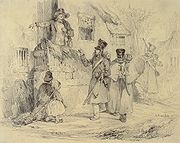
Nicolas Toussaint Charlet
Encyclopedia

France
The French Republic , The French Republic , The French Republic , (commonly known as France , is a unitary semi-presidential republic in Western Europe with several overseas territories and islands located on other continents and in the Indian, Pacific, and Atlantic oceans. Metropolitan France...
designer and painter
Painting
Painting is the practice of applying paint, pigment, color or other medium to a surface . The application of the medium is commonly applied to the base with a brush but other objects can be used. In art, the term painting describes both the act and the result of the action. However, painting is...
, more especially of military subjects, was born in Paris
Paris
Paris is the capital and largest city in France, situated on the river Seine, in northern France, at the heart of the Île-de-France region...
.
He was the son of a dragoon
Dragoon
The word dragoon originally meant mounted infantry, who were trained in horse riding as well as infantry fighting skills. However, usage altered over time and during the 18th century, dragoons evolved into conventional light cavalry units and personnel...
in the Republican
French First Republic
The French First Republic was founded on 22 September 1792, by the newly established National Convention. The First Republic lasted until the declaration of the First French Empire in 1804 under Napoleon I...
army, whose death in the ranks left the widow and orphan in very poor circumstances. Madame Charlet, however, a woman of determined spirit and an extreme Napoleonist
Napoleon I
Napoleon Bonaparte was a French military and political leader during the latter stages of the French Revolution.As Napoleon I, he was Emperor of the French from 1804 to 1815...
(Bonapartist
Bonapartist
In French political history, Bonapartism has two meanings. In a strict sense, this term refers to people who aimed to restore the French Empire under the House of Bonaparte, the Corsican family of Napoleon Bonaparte and his nephew Louis...
), managed to give her boy a moderate education at the Lycée Napoléon, and was repaid by his lifelong affection.
His first employment was a minor post in the Paris city administration, where he had to register recruits: he served in the National Guard in 1814, fought bravely at the Barrière de Clichy, and, being thus unacceptable to the Bourbon party, was dismissed from the city administration in 1816. He then, having from a very early age had a propensity for drawing, entered the atelier of the distinguished painter Baron Gros, and soon began issuing the first of those lithographed designs which eventually brought him renown.
His "Grenadier de Waterloo", 1817, with the motto "La Garde meurt et ne se rend pas" (a famous phrase frequently attributed to Cambronne
Cambronne
Pierre Jacques Étienne Cambronne, later Pierre, Viscount Cambronne , was a General of the French Empire. He fought during the wars of the Revolution and the Napoleonic Era. He was wounded at the Battle of Waterloo....
, but which he never uttered, and which cannot, perhaps, be traced farther than to this lithograph by Charlet), was particularly popular. It was only towards 1822, however, that he began to be successful in a professional sense. Lithographs (about 2000 altogether), water-colours, sepia-drawings, numerous oil sketches, and a few etchings followed one another rapidly; there were also three exhibited oil pictures, the first of which was especially admired "Episode in the Campaign of Russia" (1836), the "Passage of the Rhine by Moreau" (1837), "Wounded Soldiers Halting in a Ravine" (1843).
Besides the military subjects in which he particularly delighted, and which found an energetic response in the popular heart, and kept alive a feeling of regret for the recent past of the French nation and discontent with the present, a feeling which increased upon the artist himself towards the close of his career, Charlet designed many subjects of town life and peasant life, the ways of children, etc., with much wit and whim in the descriptive mottoes. One of the most famous sets is the "Vie civile, politique, et militaire du Caporal Valentin", 50 lithographs, dating from 1838 to 1842. In 1838 his health began to fail owing to an affection of the chest.
Charlet was an uncommonly tall man, with an expressive face, bantering and good natured; his character corresponded, full of boyish fun and high spirits, with manly independence, and a vein of religious feeling, and he was a hearty favourite among his intimates, one of whom was the painter Géricault
Théodore Géricault
Jean-Louis André Théodore Géricault was a profoundly influential French artist, painter and lithographer, known for The Raft of the Medusa and other paintings...
. Charlet married in 1824, and two sons survived him.
A life of Charlet was published in 1856 by a military friend, De la Combe.
External links
- Illustrations
- Anne S. K. Brown Military Collection, Brown University Library numerous military lithographs and some original drawings by Charlet.
----

